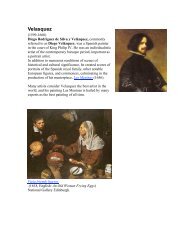Still Life in Watercolors
qbj8dgc
qbj8dgc
- No tags were found...
Create successful ePaper yourself
Turn your PDF publications into a flip-book with our unique Google optimized e-Paper software.
1893~94 (fig- 8). That canvas has a two-toned blue wall beh<strong>in</strong>d its tabletop arrangement—a<br />
peculiarly accordion-like wall that seems to have at least one extra corner<br />
crease and thus threatens to reverse the <strong>in</strong>ward recession of the wall <strong>in</strong>to outward<br />
projection—but it has no floors or room corners or extra furnish<strong>in</strong>gs to suggest<br />
walk<strong>in</strong>g, sitt<strong>in</strong>g, movement, or connection between one space and the next. What it<br />
does have—besides the familiar sugar bowl, the ubiquitous apples, and a red-striped<br />
cloth similar to the one <strong>in</strong> the Getty watercolor—is a world of prov<strong>in</strong>cial faience and<br />
fabric found throughout Cezanne's still lifes. That world is Provence through and<br />
through, from its Marseilles olive jar, to its decorated sugar bowl, to its strawwrapped<br />
g<strong>in</strong>ger pot and rum bottle, to its blue tapestry. 5 Thus the rustic objects<br />
found <strong>in</strong> this and many similar still lifes tie the signature "handwrit<strong>in</strong>g" of Cezanne<br />
to the signature of Provence, and thus despite their <strong>in</strong>significance, <strong>in</strong>deed <strong>in</strong> their<br />
very humbleness, they are significant <strong>in</strong>deed; they signify a locality, a life lived <strong>in</strong> a<br />
particular place. In that simple way at least, they are "biographical." And although the<br />
watercolor <strong>Still</strong> <strong>Life</strong> with Blue Pot has none of the pottery of the Getty oil, save for the<br />
little pitcher whose decoration is not clearly <strong>in</strong>scribed, it too is signed with a<br />
Provencal signature—nowhere more clearly than <strong>in</strong> the mounded tapestry ris<strong>in</strong>g<br />
up at the left like the hump of Mont Sa<strong>in</strong>te-Victoire and fall<strong>in</strong>g down and around to<br />
embrace the rest and determ<strong>in</strong>e the palette of the whole, a blue-, green-, red-, and<br />
ocher-dom<strong>in</strong>ated palette that is pure Provence. These were the colors, as Denis put<br />
it, of "ancient faiences," but they were also those of the earth, sky, sea, verdure,<br />
and red roofs of Cezanne's native landscape. 6<br />
IF THE GETTY STILL LIFE is Provence through and through, so was Cezanne<br />
himself, who of the pa<strong>in</strong>ters attached to the Impressionist group traveled the<br />
least; was most identified with a s<strong>in</strong>gle local landscape, that of and around Aix-en-<br />
Provence; and was least attached to the movable feast and touristic world of Paris<br />
and its suburbs and their transient population and lifestyle. Born (out of wedlock) <strong>in</strong><br />
Aix <strong>in</strong> 1839 to a hatter and his mistress and soon-to-be-wife (Louis-Auguste Cezanne<br />
and Anne Elizabeth Honor<strong>in</strong>e Aubert, a native of Aix), Cezanne grew up, went to<br />
public school and then lycee, befriended the Aixois Emile Zola and Henri Gasquet,<br />
enrolled <strong>in</strong> the Ecole Gratuite de Dess<strong>in</strong> (free school of draw<strong>in</strong>g), and went to law<br />
school at his father's <strong>in</strong>sistence, all <strong>in</strong> the good prov<strong>in</strong>cial town of Aix-en-Provence.<br />
(By that time his father had become a banker and property owner, a bon bourgeois of<br />
Aix.) Cezanne first left Aix for Paris <strong>in</strong> 1861, at Zola's urg<strong>in</strong>g. Thereafter, he went<br />
back and forth between Paris and Aix, first return<strong>in</strong>g to Aix <strong>in</strong> September of 1861,<br />
six months after hav<strong>in</strong>g left for Paris, to do a st<strong>in</strong>t <strong>in</strong> his father's bank. He returned<br />
to Paris a little over a year later, <strong>in</strong> November of 1862, and rema<strong>in</strong>ed until July of<br />
1864. He was back <strong>in</strong> Paris the next year, only to return to Aix <strong>in</strong> the w<strong>in</strong>ter. The year<br />
1866 saw him return<strong>in</strong>g to Paris and then to Aix aga<strong>in</strong>, and then back to Paris. It<br />
17<br />
THE BIOGRAPHY OF OBJECTS




